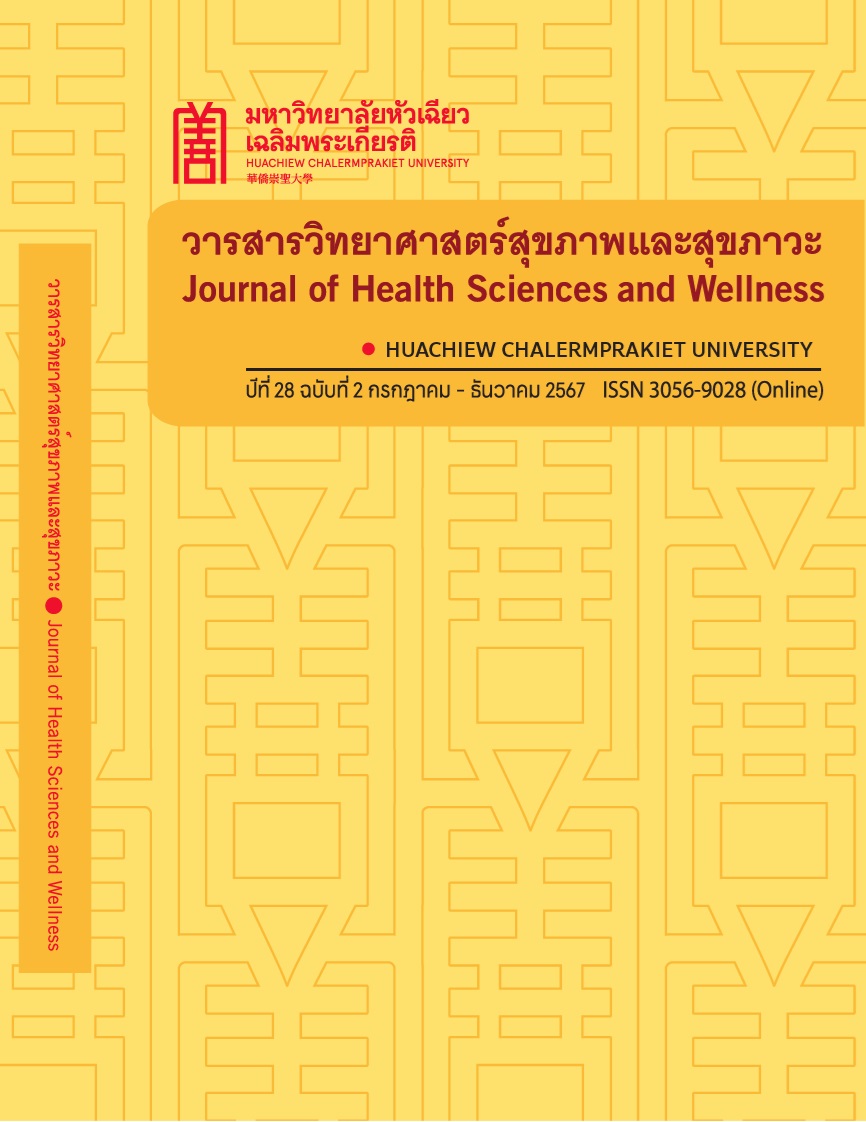The Relationship Between a History of COVID-19 Infection and Body Imbalance According to Traditional Chinese Medicine in Farmers of Pong District, Phayao Province
Keywords:
COVID-19 Body Imbalance, Chinese medicine, farmersAbstract
This research is a cross-sectional study. The objective is to investigate the relationship between imbalanced health conditions and COVID-19 infection in the high-ground farmer community in Pong district, Phayao. A total of 391 people were surveyed using stratified sampling and questionnaires. Analysis of descriptive statistics and bivariate analysis were used to find factors that have a primary relationship between the infection record and other factors, along with imbalanced health conditions. Using multivariate logistic regression confirm that the COVID-19 infection record is not a covariate of the imbalanced health condition. The research found that from 391 samples, 53.00% were female, 81.00% were 45 years or above, and 33.00% of them, or 125, were infected. After classifying by Chinese medicine, 47% of them have an imbalance health condition. They are as follows: qi stagnation (13.00%), qi deficiency (12.00%), blood stasis (8.00%), special diethesi (7.00%), yin deficiency (7.00%), phlegm-dampness (6.00%), and dampness-heat (3.00%). The multivariate analysis found that COVID-19 infection has a relationship with an imbalanced health condition (p 0.04, 95%CI 1.012-2.557). After adjusting other relevant factors such as female gender, debt, working hours (more than 8), obesity, and finger hip pain. The research concludes that COVID-19 infection has a relationship with imbalanced health conditions. To identify health management strategies based on post-COVID-19 syndrome, as well as to provide a framework for prevention and reducing morbidity rates. These findings can also be further developed into health education initiatives to equip communities with foundational knowledge for restoring bodily balance and maintaining health amidst the COVID-19 pandemic.
Downloads
References
Leso V, Fontana L, Iavicoli I. Susceptibility to Coronavirus (COVID-19) in occupational settings: the complex interplay between individual and workplace factors. Int J Environ Res Public Health. 2021;18(3):1030. doi: 10.3390/ijerph18031030. PMID: 33503829; PMCID: PMC7908348.
Lyu M, Fan G, Xiao G, Wang T, Xu D, Gao J, et al. Traditional Chinese Medicine in COVID-19. Acta Pharm Sin B. 2021;11(11):3337–63. doi: 10.1016/j.apsb.2021.09.008.
Qi W. Classification and diagnosis basis of nine basic constitutions in Chinese medicine. J Beijing Univ Tradit Chin Med. 2005;28(4):1-8. doi: https://shorturl.asia/KgzXv.
Zhu Y, Shi H, Wang Q, Wang Y, Yu X, Di J, et al. Association between nine types of TCM constitution and five chronic diseases: a correspondence analysis based on a sample of 2,660 participants. Evid Based Complement Alternat Med. 2017;9439682. doi: 10.1155/2017/9439682.
Jiayao Y, Wen S, Jie Q, Rong C, Xin L, Li W. Analysis on Traditional Chinese Medicine syndromes and constitutions of 90 patients with common COVID-19. J Tradit Chin Med. 2020;61(8):645-9.
World Health Organization. Thailand: WHO coronavirus disease (COVID-19) dashboard with vaccination data [internet]. 2024 [cited 2023 May 30]. Available from: https://covid19.who.int
Xiao JJ, Duan JS, Xu X, Li SN, Wang F, Fang QK, et al. Behavior of pesticides and their metabolites in traditional Chinese medicine Paeoniae Radix Alba during processing and associated health risk. J Pharm Biomed. 2018;161:20–7. doi: 10.1016/j.jpba.2018.08.029
Daniel WW, Cross CL. Biostatistics: a foundation for analysis in health sciences. 10th ed. Hoboken: John Wiley & Sons; 2013.
Nippanon P, Sriruacha C, Tantriratna, Phajan T, Suwannaphant K, Laohasiriwong W. Chemical pesticide use and quality of life of rubber farmers in the Northeast of Thailand. Kathmandu Univ Med J. 2019;17(1):3-8. doi: https://kumj.com.np/issue/65/3-8.pdf.
Kirkpatrick LA. A simple guide to IBM SPSS statistics for versions 20.0 & 21.0 [internet]. 2013 [cited 2013 Jul 23]. Available from: https://search.library.wisc.edu/catalog/9910207028202121
Liang L, Shengzhi W, Tongxiang Y, Nini Q. A brief analysis on the pathogenesis outcome of novel coronavirus pneumonia according to tongue coating characteristics. J Liaoning Univ Tradit Chin Med. 2020;22(3):120-3. doi: https://shorturl.asia/cehnr.
Yang X, Fang Y, Chen H, Zhang T, Yin X, Man J, et al. Global, regional and national burden of anxiety disorders from 1990 to 2019: results from the Global Burden of Disease Study 2019. Epidemiol Psychiatr Sci. 2021;30:e36. doi: 10.1017/S2045796021000275.
Li W. Research on the physical characteristics of men and women and their similarities and differences. Chin J Basic Med Tradit Chin Med. 1998; 2:7. doi: https://shorturl.asia/kOHC5.
Downloads
Published
How to Cite
Issue
Section
License
Copyright (c) 2024 Journal of Health Sciences and Wellness

This work is licensed under a Creative Commons Attribution-NonCommercial-NoDerivatives 4.0 International License.
บทความที่ได้รับการตีพิมพ์เป็นลิขสิทธิ์ของวารสารวิทยาศาสตร์สุขภาพและสุขภาวะ
ข้อความที่ปรากฏในบทความแต่ละเรื่องในวารสารวิชาการเล่มนี้เป็นความคิดเห็นส่วนตัวของผู้เขียนแต่ละท่านไม่เกี่ยวข้องกับมหาวิทยาลัยหัวเฉียวเฉลิมพระเกียรติ และคณาจารย์ท่านอื่นๆในมหาวิทยาลัยฯ แต่อย่างใด ความรับผิดชอบองค์ประกอบทั้งหมดของบทความแต่ละเรื่องเป็นของผู้เขียนแต่ละท่าน หากมีความผิดพลาดใดๆ ผู้เขียนแต่ละท่านจะรับผิดชอบบทความของตนเองแต่ผู้เดียว




